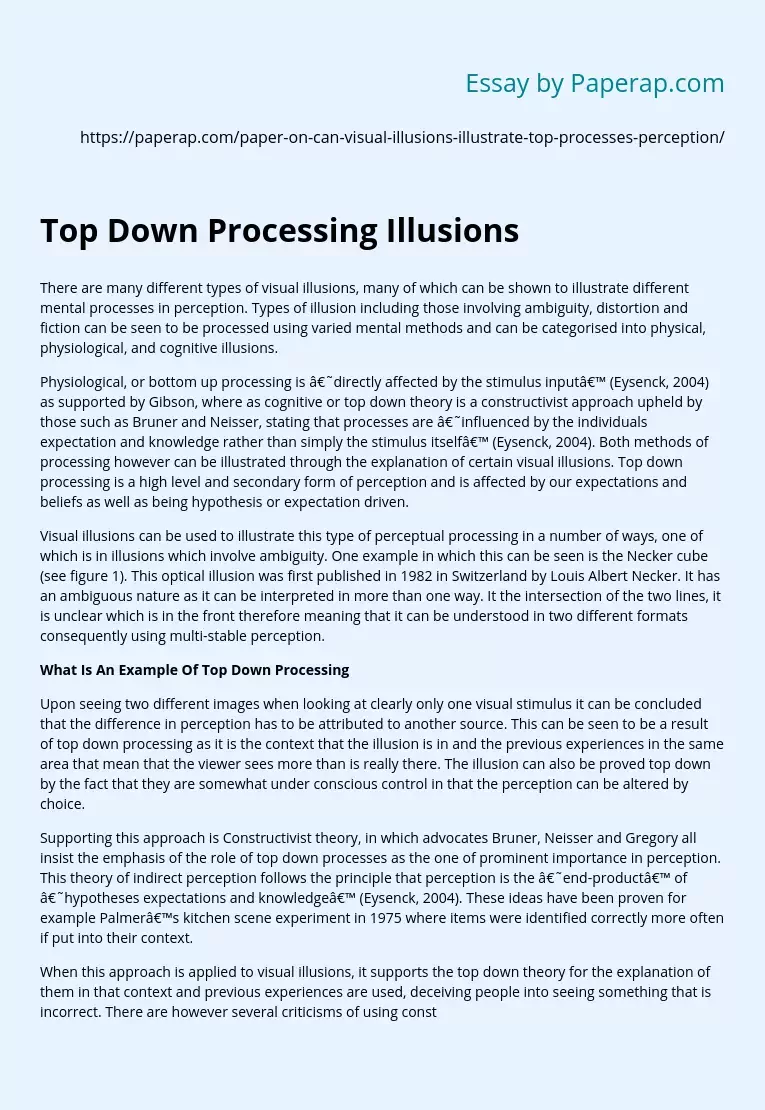Top Down Processing Illusions
There are many different types of visual illusions, many of which can be shown to illustrate different mental processes in perception. Types of illusion including those involving ambiguity, distortion and fiction can be seen to be processed using varied mental methods and can be categorised into physical, physiological, and cognitive illusions.
Physiological, or bottom up processing is ‘directly affected by the stimulus input’ (Eysenck, 2004) as supported by Gibson, where as cognitive or top down theory is a constructivist approach upheld by those such as Bruner and Neisser, stating that processes are ‘influenced by the individuals expectation and knowledge rather than simply the stimulus itself’ (Eysenck, 2004).
Both methods of processing however can be illustrated through the explanation of certain visual illusions. Top down processing is a high level and secondary form of perception and is affected by our expectations and beliefs as well as being hypothesis or expectation driven.
Visual illusions can be used to illustrate this type of perceptual processing in a number of ways, one of which is in illusions which involve ambiguity.
One example in which this can be seen is the Necker cube (see figure 1). This optical illusion was first published in 1982 in Switzerland by Louis Albert Necker. It has an ambiguous nature as it can be interpreted in more than one way. It the intersection of the two lines, it is unclear which is in the front therefore meaning that it can be understood in two different formats consequently using multi-stable perception.
What Is An Example Of Top Down Processing
Upon seeing two different images when looking at clearly only one visual stimulus it can be concluded that the difference in perception has to be attributed to another source.
This can be seen to be a result of top down processing as it is the context that the illusion is in and the previous experiences in the same area that mean that the viewer sees more than is really there. The illusion can also be proved top down by the fact that they are somewhat under conscious control in that the perception can be altered by choice.
Supporting this approach is Constructivist theory, in which advocates Bruner, Neisser and Gregory all insist the emphasis of the role of top down processes as the one of prominent importance in perception. This theory of indirect perception follows the principle that perception is the ‘end-product’ of ‘hypotheses expectations and knowledge’ (Eysenck, 2004). These ideas have been proven for example Palmer’s kitchen scene experiment in 1975 where items were identified correctly more often if put into their context.
When this approach is applied to visual illusions, it supports the top down theory for the explanation of them in that context and previous experiences are used, deceiving people into seeing something that is incorrect. There are however several criticisms of using constructivism to prove top down theory in illusions. One way in which is that one of the main principle of constructivism is that perception reached by hypothesis is prone to error, however in everyday life it can be seen that this is not the case.
In addition, many of the experiments that prove the constructivist theory are artificial and inconsistent with normal life. Visual illusions can also be explained from a bottom up perspective. This primary form of cognition is low level and uses serial processing as ‘one process is completed before the next begins’ (Eysenck, 2004). This form of perceptual information processing is frequently ‘data driven’ and is predominantly involuntary, not being influenced by context or hypothesis.
Visual illusions can be used to explain this type of perceptual processing in a number of ways, one of which is in illusions which involve fiction. One example of which is the illusion of the Mach Bands (see figure 2). This illusion was created by Italian psychologist Ernst Mach and can be seen practical terms in medicine when examining x-rays. Mach Bands is a fictional illusion as the eye tends to interpret either a bright or dark vertical band near the area where there is a strong gradient change in the color, when in fact none exists.
This is supposedly due to ‘lateral inhibition of the receptors in the eye’ however it can also be attributed to the ‘statistical strategy of visual perception’ (Lotto, Williams, Purves, 1999). This illusion can be explained through bottom up perception processes and constasts sharply with top down theory as it does not use previous knowledge or context to delude the viewer, it is purely an automatic, low-level mechanism without hypothesis or expectation. An argument which supports this approach is the theory of Direct perception, maintained by the American psychologist James Gibson.
He claimed there is ‘information available in sensory stimulation’ (Eysenck, 2004) and his main principles include ‘structured light contains visual information from the environment’, and that this provides ‘information about the layout of objects’ also that perception involves picking up this information ‘with little or no information processing being involved’ (Eysenck, 2004). These principles were proven by Gibson in 1950 using his pilot experiment in which he observed the pilots processing information from the environment with little or no expectation or hypothesis involved in relation to factors such as direction speed and altitude.
When this approach is applied to visual illusions, it supports the bottom up theory for the explanation of them in that it shows visual information being absorbed without considering context. However there are several criticisms of Gibson’s direct theory of perception, one of which being that processes are more complex than stated in his experiments, and another that his principles apply much more to some aspects of perception than to others. He also was incorrect in disregarding the use of ‘internal representations to understand perception’ (Eysenck, 2004) for example memory which was later proved erroneous by the work of Menzel.
Top Down Processing Illusions. (2019, Dec 05). Retrieved from https://paperap.com/paper-on-can-visual-illusions-illustrate-top-processes-perception/

